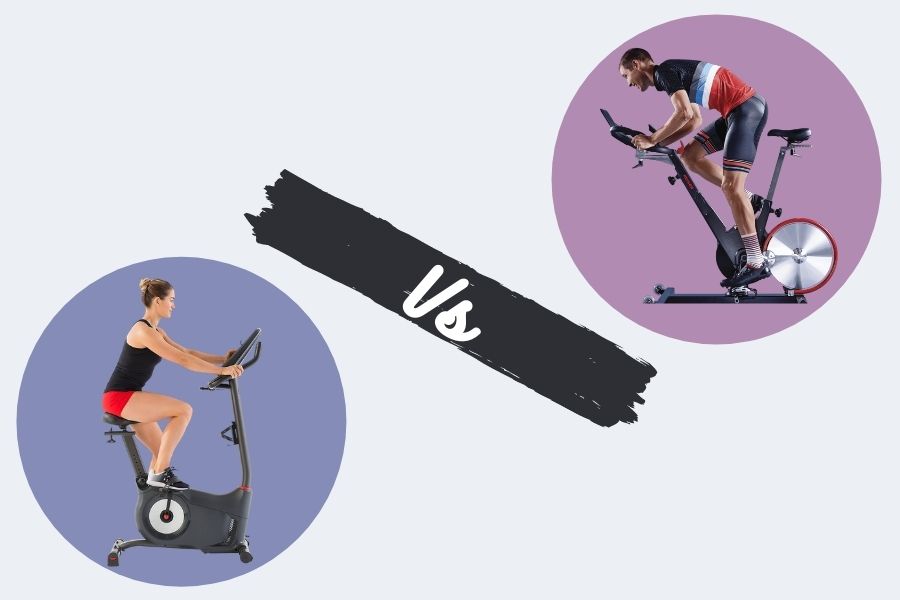Stationary bikes are a popular piece of equipment for your home gym. If you’ve searched the market, you’ll know there are many different types of stationary bikes. Some of the most popular include indoor cycles and upright bikes. Throughout this article, we’re going to discuss their differences and help you decide which is best for you.
Indoor Cycle / Spin® Bike

What Is It?
Indoor cycles, also known as Spin® bikes, became popular in the early ’90s. The significant rise in Spin® classes boomed the indoor cycle industry. Indoor cycles are designed to mimic the feeling of being on a real-life road
Yet, unlike real-life road bikes, indoor cycles contain a heavy flywheel. The flywheel is connected to the pedals via a chain. Resistance on the flywheel can be adjusted to mimic the resistance experienced on a road
Higher-end indoor cycles are compatible with a range of apps and programs. Programs guide you through a range of Spin® style classes. If you’re unsure how to train or need some extra motivation, joining a class is a great option. Better yet, you can do it in the comfort of your own home without having to work out in a room full of sweaty people.
Indoor Cycles: Pros & Cons
Stationary/Upright Bike

What Is It?
Upright bikes are like the indoor cycle’s predecessor. They’ve been around for a long time and have evolved over the years. As the name suggests, your body is placed in an upright position during cycling. Some people find an upright position more comfortable. Many users say less strain is placed on their lower back.
Many upright bikes are foldable. If you live in a small apartment or don’t have much room to spare, they can be a great space-saving option. Foldable upright bikes can be stored in a spare cupboard or the corner of a room.
Most upright bikes are manufactured using a crankshaft and bottom bracket, which turns the flywheel via a chain or belt. Upright bikes use either electromagnetic, magnetic, or fan resistance. Upright bikes usually include features such as calories burned, heart rate, distance, and speed. Additionally, some have many preset programs that take you through a guided session. Another great feature of the upright
Indoor Cycles: Pros & Cons
Differences

Resistance
Indoor cycles mimic the action of a road
Related
Magnetic vs Friction Resistance Exercise Bikes
Seated Position
Indoor cycles put your body in the optimal position for riding. The seat on an indoor cycle is higher than the handlebars, thus you’ll adopt a slight leaning position. This position is also what you’ll experience on a road
Gadgets
Gadgets will depend on the model. Many upright bikes contain a monitor that displays calories burned, heart rate, distance, and speed. These metrics are useful when you have specific training goals. Heart rate is particularly useful when aiming for different exercise intensities. Additionally, many upright bikes contain pre-set programs to help guide you through a workout. Many indoor cycles do not display calories burned, heart rate, distance, and speed. But, some models are compatible with various apps and programs that take you through a typical Spin® style session. This is a great feature for those who need a bit of extra motivation during a workout.
Handlebars
The handlebars on an indoor cycle are like the ones you’d find on a road
Space
Indoor cycles can be a bit bulky, therefore need a fair amount of room. Upright bikes are of a similar size, but many models are foldable. Thus, you’ll only need a bit of space when you’re using the
Seat
Indoor cycles contain a seat like what you’d find on a road
Pedals
The main difference between the pedals is indoor cycles are generally compatible with clip-on shoes. Securing your foot to the pedal can help exert more power through the pedals and thus aid performance. Pedals on an upright
Price
Price varies between low- and high-end models for both the indoor cycle and upright bikes. But, generally speaking, upright bikes are cheaper than indoor cycles.
FAQ’s
Which Is Better a Spin® Bike / Indoor Cycle or Exercise Bike?
It depends on your requirements. Indoor cycles are better for serious athletes trying to improve their performance. Exercise bikes are better for the recreational person aiming to improve their health and fitness.
Can You Use a Spin® Bike / Indoor Cycle as a Normal Exercise Bike?
Yes, absolutely. Indoor cycles are designed for performance, but the average person can also use them for general exercise. However, unlike upright bikes, indoor bikes put your body in a leaning position. Some people don’t feel comfortable over the handlebars; therefore, they don’t get on well with an indoor cycle.
Verdict: Which is the best for me?
Which
